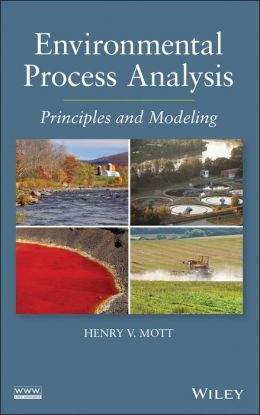 [内容简介]
[内容简介]
Enables readers to apply core principles of environmental engineering to analyze environmental systems
Environmental Process Analysis takes a unique approach, applying mathematical and numerical process modeling within the context of both natural and engineered environmental systems. Readers master core principles of natural and engineering science such as chemical equilibria, reaction kinetics, ideal and non-ideal reactor theory, and mass accounting by performing practical real-world analyses. As they progress through the text, readers will have the opportunity to analyze a broad range of environmental processes and systems, including water and wastewater treatment, surface mining, agriculture, landfills, subsurface saturated and unsaturated porous media, aqueous and marine sediments, surface waters, and atmospheric moisture.
The text begins with an examination of water, core definitions, and a review of important chemical principles. It then progressively builds upon this base with applications of Henry's law, acid/base equilibria, and reactions in ideal reactors. Finally, the text addresses reactions in non-ideal reactors and advanced applications of acid/base equilibria, complexation and solubility/dissolution equilibria, and oxidation/reduction equilibria.
Several tools are provided to fully engage readers in mastering new concepts and then applying them in practice, including:
- Detailed examples that demonstrate the application of concepts and principles
- Problems at the end of each chapter challenging readers to apply their newfound knowledge to analyze environmental processes and systems
- MathCAD worksheets that provide a powerful platform for constructing process models
Environmental Process Analysis serves as a bridge between introductory environmental engineering textbooks and hands-on environmental engineering practice. By learning how to mathematically and numerically model environmental processes and systems, readers will also come to better understand the underlying connections among the various models, concepts, and systems.
[目录]
Preface xiii
Acknowledgments xvii
1. Introductory Remarks 1
1.1 Perspective / 1
1.2 Organization and Objectives / 2
1.3 Approach / 8
2. Water 11
2.1 Perspective / 11
2.2 Important Properties of Water / 12
3. Concentration Units for Gases, Liquids, and Solids 16
3.1 Selected Concentration Units / 16
3.2 The Ideal Gas Law and Gas Phase Concentration Units / 20
3.3 Aqueous Concentration Units / 23
3.4 Applications of Volume Fraction Units / 28
4. The Law of Mass Action and Chemical Equilibria 36
4.1 Perspective / 36
4.2 The Law of Mass Action / 37
4.3 Gas/Water Distributions / 38
4.4 Acid/Base Systems / 39
4.5 Metal Complexation Systems / 40
4.6 Water/Solid Systems (Solubility/Dissolution) / 41
4.7 Oxidation/Reduction Half Reactions / 43
5. Air / Water Distribution: Henry’s Law 44
5.1 Perspective / 44
5.2 Henry’s Law Constants / 46
5.3 Applications of Henry’s Law / 51
6. Acid/Base Component Distributions 64
6.1 Perspective / 64
6.2 Proton Abundance in Aqueous Solutions: pH and the Ion Product of Water / 65
6.3 Acid Dissociation Constants / 69
6.4 Mole Accounting Relations / 70
6.5 Combination of Mole Balance and Acid/Base Equilibria / 74
6.6 Alkalinity, Acidity, and the Carbonate System / 82
6.7 Applications of Acid/Base Principles in Selected Environmental Contexts / 91
7. Mass Balance, Ideal Reactors, and Mixing 119
7.1 Perspective / 119
7.2 The Mass Balance / 120
7.3 Residence Time Distribution (RTD) Analyses / 121
7.4 Exit Responses for Ideal Reactors / 125
7.5 Modeling of Mixing in Ideal CMFRs / 130
7.6 Applications of CMFR Mixing Principles in Environmental Systems / 144
8. Reactions in Ideal Reactors 157
8.1 Perspective / 157
8.2 Chemical Stoichiometry and Mass/Volume Relations / 158
8.3 Reactions in Ideal Reactors / 171
8.4 Applications of Reactions in Ideal Reactors / 183
8.5 Interfacial Mass Transfer in Ideal Reactors / 216
9. Reactions in Nonideal Reactors 265
9.1 Perspective / 265
9.2 Exit Concentration Versus Time Traces / 266
9.3 Residence Time Distribution Density / 267
9.4 Cumulative Residence Time Distributions / 271
9.5 Characterization of RTD Distributions / 272
9.6 Models for Addressing Longitudinal Dispersion in Reactors / 275
9.7 Modeling Reactions in CMFRs in Series (TiS) Reactors / 280
9.8 Modeling Reactions with the Plug-Flow with Dispersion Model / 282
9.9 Modeling Reactions Using the Segregated Flow (SF) Model / 289
9.10 Applications of Nonideal Reactor Models / 291
9.11 Considerations for Analyses of Spatially Variant Processes / 305
9.12 Modeling Utilization and Growth in PFR-Like Reactors Using TiS and SF / 318
10. Acid-Base Advanced Principles 335
10.1 Perspective / 335
10.2 Activity Coefficient / 336
10.3 Temperature Dependence of Equilibrium Constants / 344
10.4 Nonideal Conjugate Acid/Conjugate Base Distributions / 350
10.5 The Proton Balance (Proton Condition) / 358
10.6 Analyses of Solutions Prepared by Addition of Acids, Bases, and Salts to Water / 365
10.7 Analysis of Mixed Aqueous Solutions / 380
10.8 Acid and Base Neutralizing Capacity / 396
10.9 Activity Versus Concentration for Nonelectrolytes / 417
11. Metal Complexation and Solubility 439
11.1 Perspective / 439
11.2 Hydration of Metal Ions / 440
11.3 Cumulative Formation Constants / 441
11.4 Formation Equilibria for Solids / 447
11.5 Speciation of Metals in Aqueous Solutions Containing Ligands / 448
11.6 Metal Hydroxide Solubility / 456
11.7 Solubility of Metal Carbonates / 467
11.8 Solubility of Other Metal–Ligand Solids / 511
12. Oxidation and Reduction 519
12.1 Perspective / 519
12.2 Redox Half Reactions / 520
12.3 The Nernst Equation / 533
12.4 Electron Availability in Environmental Systems / 535
Appendices 571
References 599
Index 602

 新书报道
新书报道